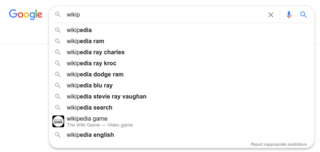Related Research Articles
In computing, Common Gateway Interface (CGI) is an interface specification that enables web servers to execute an external program to process HTTP or HTTPS user requests.
Server-side scripting is a technique used in web development which involves employing scripts on a web server which produces a response customized for each user's (client's) request to the website. Scripts can be written in any of a number of server-side scripting languages that are available. Server-side scripting is distinguished from client-side scripting where embedded scripts, such as JavaScript, are run client-side in a web browser, but both techniques are often used together. The alternative to either or both types of scripting is for the web server itself to deliver a static web page.

robots.txt is the filename used for implementing the Robots Exclusion Protocol, a standard used by websites to indicate to visiting web crawlers and other web robots which portions of the website they are allowed to visit.
A web directory or link directory is an online list or catalog of websites. That is, it is a directory on the World Wide Web of the World Wide Web. Historically, directories typically listed entries on people or businesses, and their contact information; such directories are still in use today. A web directory includes entries about websites, including links to those websites, organized into categories and subcategories. Besides a link, each entry may include the title of the website, and a description of its contents. In most web directories, the entries are about whole websites, rather than individual pages within them. Websites are often limited to inclusion in only a few categories.
Search engine optimization (SEO) is the process of improving the quality and quantity of website traffic to a website or a web page from search engines. SEO targets unpaid traffic rather than direct traffic or paid traffic. Unpaid traffic may originate from different kinds of searches, including image search, video search, academic search, news search, and industry-specific vertical search engines.

Googlebot is the web crawler software used by Google that collects documents from the web to build a searchable index for the Google Search engine. This name is actually used to refer to two different types of web crawlers: a desktop crawler and a mobile crawler.
Google AdSense is a program run by Google through which website publishers in the Google Network of content sites serve text, images, video, or interactive media advertisements that are targeted to the site content and audience. These advertisements are administered, sorted, and maintained by Google. They can generate revenue on either a per-click or per-impression basis. Google beta-tested a cost-per-action service, but discontinued it in October 2008 in favor of a DoubleClick offering. In Q1 2014, Google earned US$3.4 billion, or 22% of total revenue, through Google AdSense. AdSense is a participant in the AdChoices program, so AdSense ads typically include the triangle-shaped AdChoices icon. This program also operates on HTTP cookies. In 2021, over 38.3 million websites use AdSense.

AVG AntiVirus is a line of antivirus software developed by AVG Technologies, a subsidiary of Avast, a part of Gen Digital. It is available for Windows, macOS and Android.
In the context of a web browser, a frame is a part of a web page or browser window which displays content independent of its container, with the ability to load content independently. The HTML or media elements in a frame may come from a web site distinct from the site providing the enclosing content. This practice, known as framing, is today often regarded as a violation of same-origin policy.
A web framework (WF) or web application framework (WAF) is a software framework that is designed to support the development of web applications including web services, web resources, and web APIs. Web frameworks provide a standard way to build and deploy web applications on the World Wide Web. Web frameworks aim to automate the overhead associated with common activities performed in web development. For example, many web frameworks provide libraries for database access, templating frameworks, and session management, and they often promote code reuse. Although they often target development of dynamic web sites, they are also applicable to static websites.
Sitemaps is a protocol in XML format meant for a webmaster to inform search engines about URLs on a website that are available for web crawling. It allows webmasters to include additional information about each URL: when it was last updated, how often it changes, and how important it is in relation to other URLs of the site. This allows search engines to crawl the site more efficiently and to find URLs that may be isolated from the rest of the site's content. The Sitemaps protocol is a URL inclusion protocol and complements robots.txt, a URL exclusion protocol.

Progressive enhancement is a strategy in web design that puts emphasis on web content first, allowing everyone to access the basic content and functionality of a web page, while users with additional browser features or faster Internet access receive the enhanced version instead. This strategy speeds up loading and facilitates crawling by web search engines, as text on a page is loaded immediately through the HTML source code rather than having to wait for JavaScript to initiate and load the content subsequently, meaning content ready for consumption "out of the box" is served immediately, and not behind additional layers.
nofollow is a setting on a web page hyperlink that directs search engines not to use the link for page ranking calculations. It is specified in the page as a type of link relation; that is: <a rel="nofollow" ...>. Because search engines often calculate a site's importance according to the number of hyperlinks from other sites, the nofollow setting allows website authors to indicate that the presence of a link is not an endorsement of the target site's importance.

A search engine is a software system that provides hyperlinks to web pages and other relevant information on the Web in response to a user's query. The user inputs a query within a web browser or a mobile app, and the search results are often a list of hyperlinks, accompanied by textual summaries and images. Users also have the option of limiting the search to a specific type of results, such as images, videos, or news.
Google Search Console is a web service by Google which allows webmasters to check indexing status, search queries, crawling errors and optimize visibility of their websites.

Yahoo! Kids is a public web portal provided by Yahoo! Japan to find age-appropriate online content for children between the ages of 4 and 12. This site was formerly available in English via Yahoo!, where it was known as Yahooligans! until December 2006, and in Korean via Yahoo! Korea.
Schema.org is a reference website that publishes documentation and guidelines for using structured data mark-up on web-pages. Its main objective is to standardize HTML tags to be used by webmasters for creating rich results about a certain topic of interest. It is a part of the semantic web project, which aims to make document mark-up codes more readable and meaningful to both humans and machines.

Sage Weil is the founder and chief architect of Ceph, a distributed storage platform. He also was the creator of WebRing, a co-founder of Los Angeles–based hosting company DreamHost, and the founder and CTO of Inktank. Weil now works for Red Hat as the chief architect of the Ceph project.
A headless browser is a web browser without a graphical user interface.
The JIBIN Server is or was a combined "HTTP, HTTPS, XMPP, FTP, SMTP, POP3, DNS, DHCP, Java Servlet, JSP, and proxy server" developed by Tod Sambar. The Proxy Server provided also a dial-on-demand service to an Internet service provider.
References
- ↑ ICT Roger Crawford - Heinemann IGCSE - glossary
- ↑ ICT Roger Crawford - Heinemann IGCSE - Chapter 7 page 192
- 1 2 3 4 5 "What Ever Happened To Webrings?". 14 May 2021. Archived from the original on 2017-02-04.
- ↑ "Expanding Unidirectional Ring Of Pages". Archived from the original on 2005-04-05. Retrieved 2005-04-19.
- ↑ Newton, Matthew (1998-04-15). "The 1st annual Web Innovator Awards - Sage Weil, Webring". Builder.com. Archived from the original on 2000-08-15. Retrieved 2016-07-17.
- ↑ Mieszkowski, Katharine (2001-12-05). "The strange saga of Yahoo and WebRing". Salon.com.
- ↑ "Member Program Transition". WebRing. Retrieved 2007-01-01.
- ↑ "Free Web Rings". WebRingo. Retrieved 2013-05-26.
- ↑ "WebRingo". Archived from the original on 1 August 2006. Retrieved 2013-05-26.
- ↑ "the alternative webring system". alt-webring.com. Retrieved 2013-05-26.
- ↑ Ringlink. "Ringlink Homepage". Ringlink.org. Retrieved 2013-05-26.
- ↑ "Alt-webring". Archived from the original on 6 April 2003. Retrieved 2022-08-05.
- ↑ "RingSurf.com". Archived from the original on 1998-06-12. Retrieved 2009-06-12.
- ↑ "RingSurf". 1998-06-12. Archived from the original on June 12, 1998. Retrieved 2013-05-26.
- ↑ Ringlink Free CGI Perl program for running webrings Archived 2009-07-06 at the Wayback Machine
- ↑ "SimpleRing". Archived from the original on 2009-04-20. Retrieved 2009-04-20.
- ↑ "PHP-Ring". Archived from the original on 2009-02-09. Retrieved 2009-04-11.
- ↑ Ringmaker